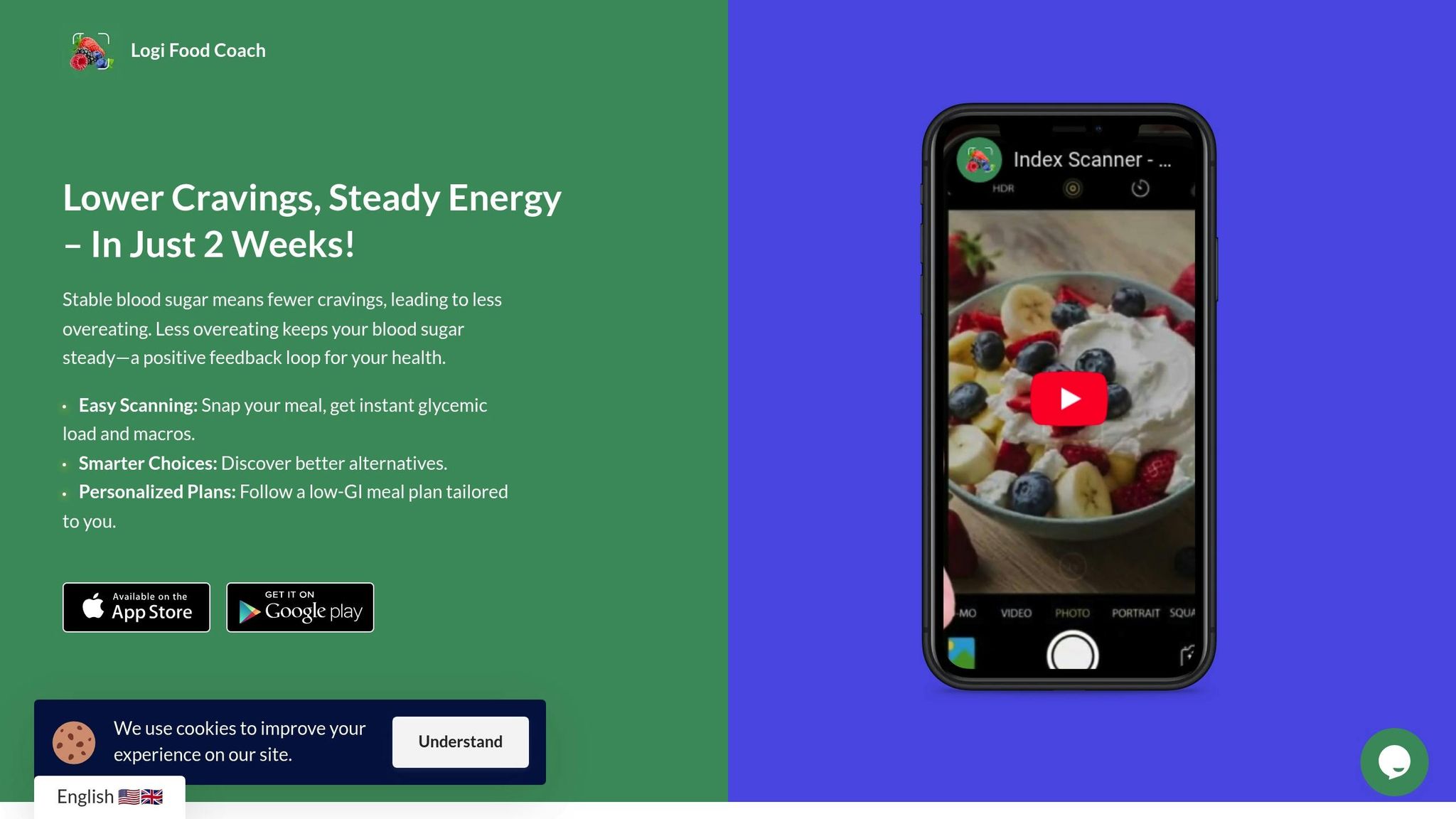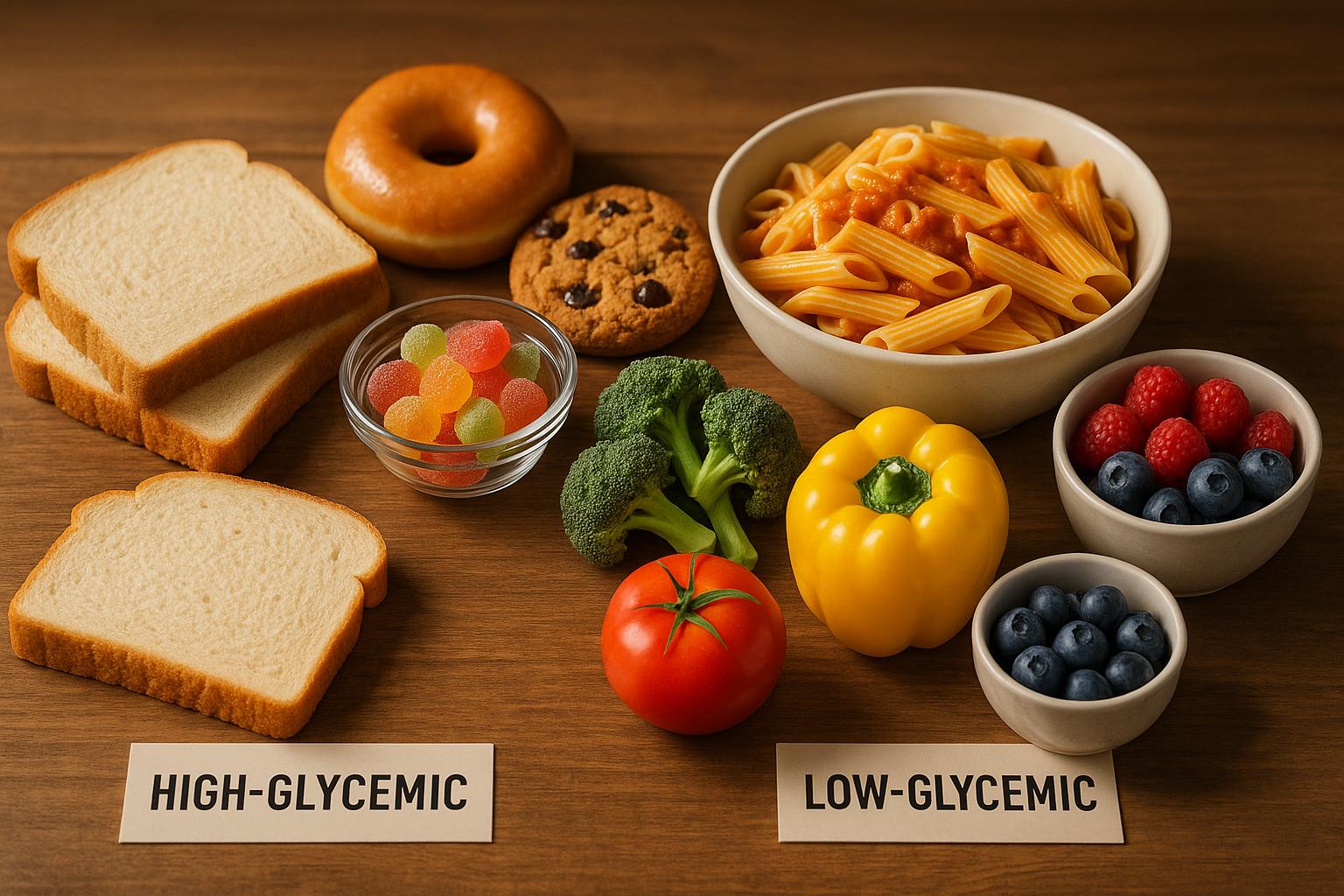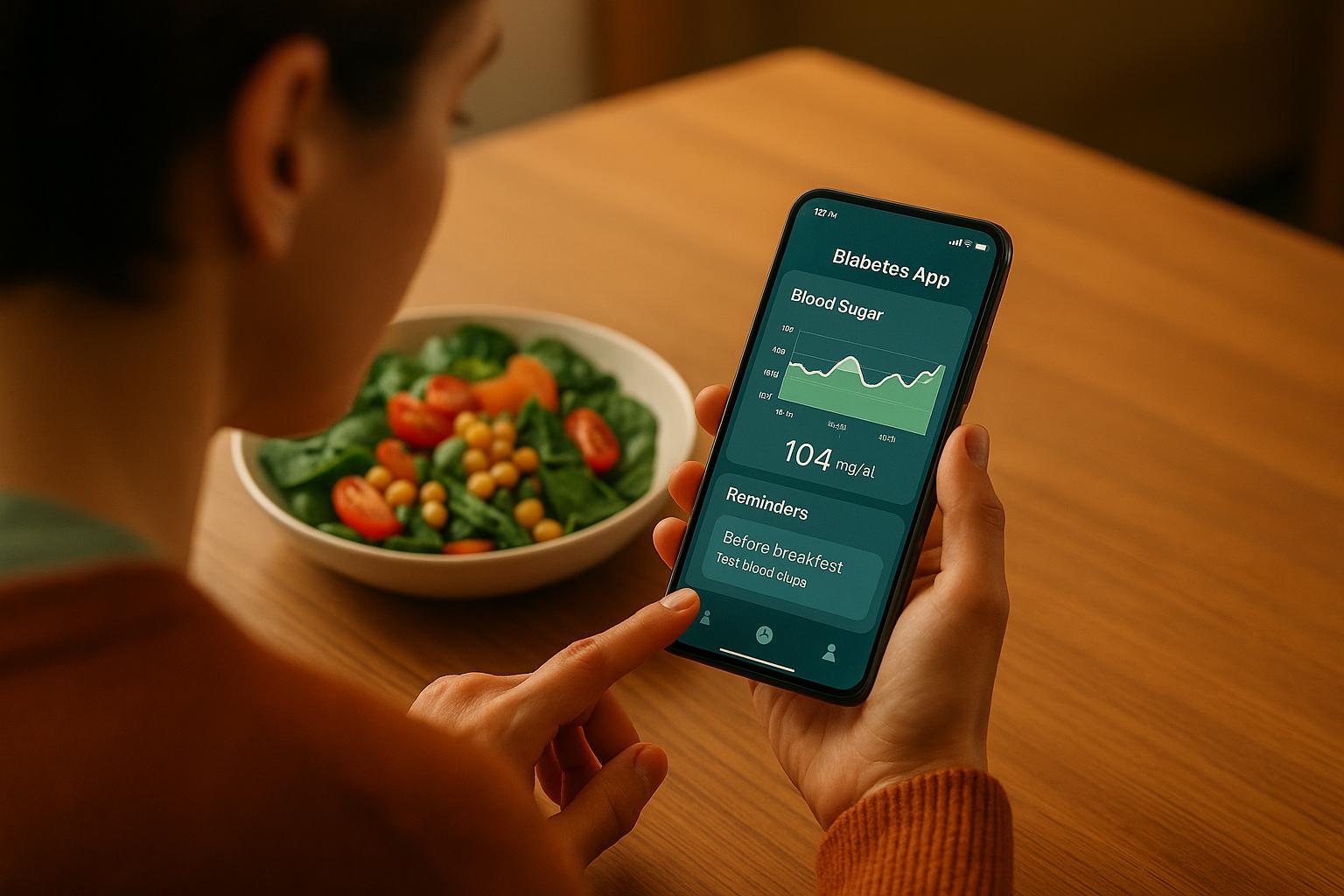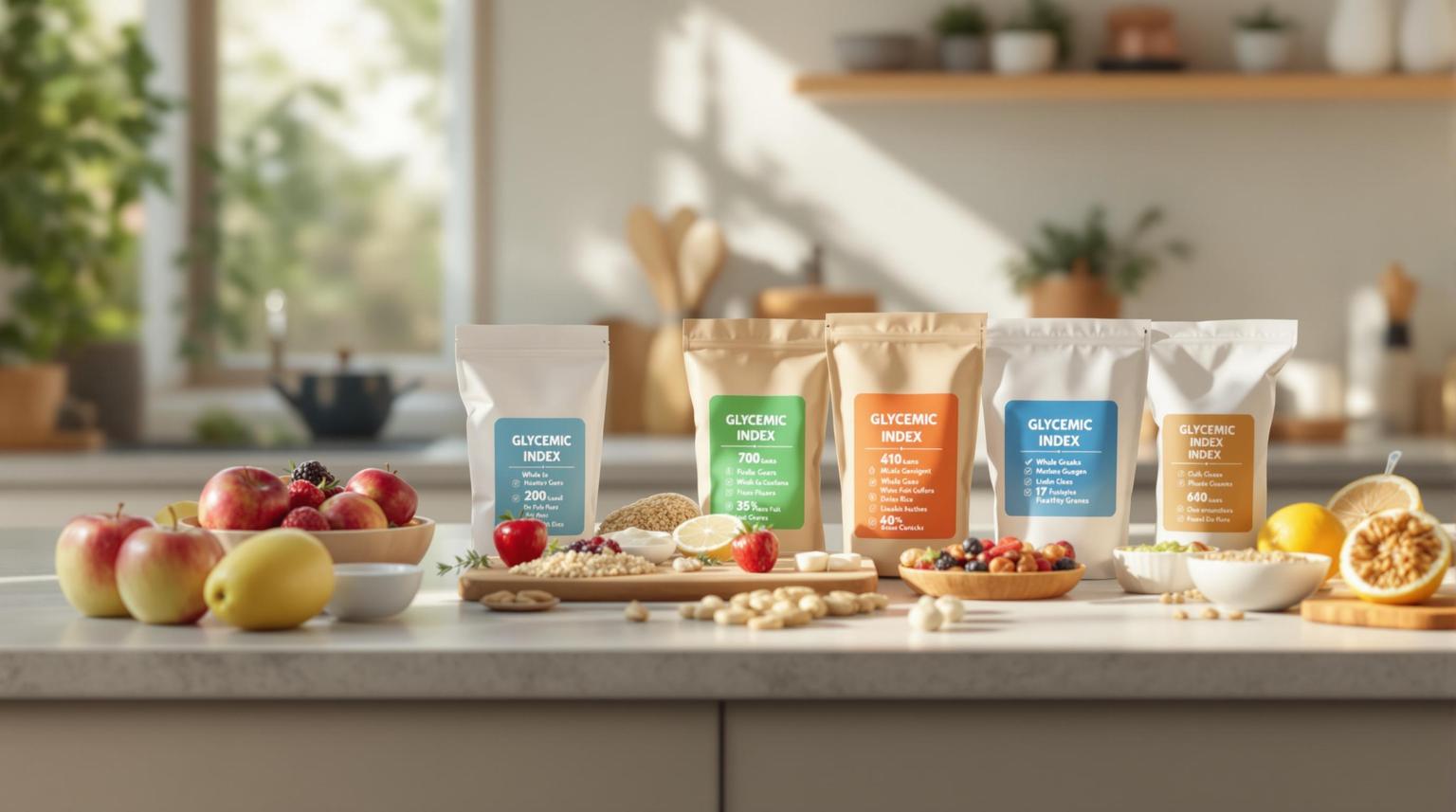Want to manage your blood sugar while enjoying seasonal fruits? Here’s what you need to know: Glycemic load (GL) measures how a specific serving of food impacts your blood sugar. Unlike glycemic index (GI), GL accounts for portion size, making it a practical tool for real-world eating. Seasonal fruits, whether summer’s hydrating berries or winter’s nutrient-rich citrus, can support blood sugar control when chosen wisely.
Key Takeaways:
- Summer Fruits: Typically lighter, hydrating, and low in glycemic load. Examples include watermelon (GL: 5.6–8.0), strawberries (GL: 1.9), and peaches (GL: 4.0).
- Winter Fruits: Packed with fiber and essential nutrients. Examples include apples (GL: 4.0–6.2), oranges (GL: 4.4–6.8), and pears (GL: 4.3).
- Smart Pairings: Combine fruits with protein or healthy fats (e.g., apple slices with almond butter) to stabilize blood sugar.
- Portion Control: Smaller servings of higher-sugar fruits like mangoes or grapes help avoid spikes.
Quick Tip: Eating fruits in season maximizes their flavor and nutrient content. For example, summer strawberries have more antioxidants, while winter oranges deliver immune-boosting vitamin C.
Quick Comparison:
| Season | Example Fruits | Average GL | Key Nutrients |
|---|---|---|---|
| Summer | Watermelon, Berries | Low | Vitamin C, Fiber |
| Winter | Apples, Oranges, Pears | Low | Fiber, Vitamin C |
Bottom Line: Seasonal fruits can fit into a blood sugar-friendly diet when you focus on glycemic load, portion sizes, and pairings. Stay consistent and enjoy the variety year-round!
Top 5 Low Glycemic Super Fruits: Health Hack- Thomas DeLauer
Summer Fruits: Glycemic Load and Health Benefits
Summer is the season of vibrant, juicy fruits that not only taste amazing but can also be a great choice for managing blood sugar levels. Many of these fruits have a low glycemic load, which means they provide a steady release of energy - perfect for those long, sunny days.
Common Summer Fruits and Their Glycemic Load
What makes these summer fruits so appealing is their low glycemic load, even if some have a higher glycemic index. Check out the table below for a closer look at their glycemic profiles:
| Fruit | Glycemic Index (GI) | Glycemic Load (GL) per serving | GL Category |
|---|---|---|---|
| Watermelon | 75–76 | 5.6–8.0 | Low |
| Mango | 51–56 | 8.4 | Low |
| Sweet Cherries | 20–25 | 4.0 | Low |
| Strawberries | 25 | 1.9 | Low |
| Peaches | 35 | 4.0 | Low |
| Blueberries | 25–53 | 2.0 | Low |
This table highlights how these fruits stack up in terms of glycemic index and load, helping you make informed dietary choices.
Health Benefits of Summer Fruits
Fruits with low glycemic load values can help keep your blood sugar levels stable, making them a smart addition to your summer diet. Take watermelon, for example - it not only supports blood sugar management but also keeps you hydrated, thanks to its high water and fiber content. Incorporating these fruits into your meals or snacks can bring a refreshing burst of flavor while keeping your energy levels steady.
Winter Fruits: Glycemic Load and Health Benefits
When winter rolls around, the fruit aisle transforms, offering a new selection of seasonal options that are both nutritious and friendly to blood sugar levels. These cold-weather staples not only last longer but also deliver essential nutrients at a time when fresh produce might feel harder to come by. Many of these fruits boast low glycemic loads, making them excellent choices for keeping your energy steady during the chilly months.
Common Winter Fruits and Their Glycemic Load
Winter fruits often don’t get the recognition they deserve for supporting healthy blood sugar levels. But their glycemic profiles show they’re a great ally for glycemic control. Here's a quick look at how some popular winter fruits rank:
| Fruit | Glycemic Index (GI) | Glycemic Load (GL) per serving | GL Category |
|---|---|---|---|
| Apples | 28–44 | 4.0–6.2 | Low |
| Pears | 33–42 | 4.3 | Low |
| Oranges | 31–51 | 4.4–6.8 | Low |
| Grapefruit | 25 | 3.0 | Low |
| Plums | 24–55 | 2.9–5.5 | Low |
| Kiwi | 47–58 | 7.3 | Low |
Health Benefits of Winter Fruits
Winter fruits don’t just keep your blood sugar in check - they come packed with other health benefits too. Take apples and pears, for example. Their high soluble fiber content helps slow sugar absorption, keeping glucose levels steady for hours. This same fiber also supports digestion, which can be especially useful when winter diets often lean toward heavier, low-fiber meals.
Then there’s the immune-boosting power of fruits like oranges and grapefruits. Rich in vitamin C, they’re a natural way to bolster your defenses during cold and flu season. A medium orange, for instance, delivers about 70 mg of vitamin C while only adding 4.4–6.8 to your daily glycemic load. That’s a win for both your health and your energy levels.
Winter fruits also shine when it comes to meal planning. Their natural sweetness can curb sugar cravings in a healthier way, and fruits like apples can be stored for months, ensuring you have a low-GL option on hand all season long.
Finally, the combination of fiber and water in these fruits helps you feel full, which is especially helpful when comforting winter dishes might tempt you to overindulge.
sbb-itb-0899721
Summer vs Winter Fruits: Glycemic Load Comparison
After looking at the unique benefits of seasonal fruits, it’s helpful to compare how these fruits contribute to balanced blood sugar and overall nutrition. Seasonal differences don’t just affect taste - they also influence glycemic load and how the body processes sugars.
Fruit Comparison Table
| Fruit | Season | Key Nutrients |
|---|---|---|
| Strawberries | Summer | Vitamin C, anthocyanins |
| Blueberries | Summer | Anthocyanins, vitamin K |
| Raspberries | Summer | Fiber, vitamin C |
| Blackberries | Summer | Vitamin K, manganese |
| Watermelon | Summer | Lycopene, vitamin A |
| Peaches | Summer | Vitamin A, potassium |
| Apples | Winter | Fiber, vitamin C |
| Pears | Winter | Fiber, vitamin K |
| Oranges | Winter | Vitamin C, folate |
| Grapefruit | Winter | Vitamin C, lycopene |
Key Differences Between Summer and Winter Fruits
Summer fruits, particularly berries, are packed with antioxidants and fiber, which help slow carbohydrate absorption and keep blood sugar levels steady. These fruits often shine during their peak season, offering higher concentrations of beneficial compounds like anthocyanins and phenolics.
Winter fruits, on the other hand, bring their own strengths. They’re rich in fiber and essential nutrients, which support metabolic health and contribute to blood sugar management. For example, apples and pears provide a steady source of fiber, while citrus fruits like oranges and grapefruit deliver a boost of vitamin C and other nutrients.
Interestingly, fruits harvested at their peak season tend to have higher levels of beneficial compounds. For instance, summer strawberries often contain more phenolic compounds than those grown out of season. This means eating fruits in their natural season not only enhances their flavor but also amplifies their potential to support healthy blood sugar levels.
Incorporating both summer and winter fruits into your meals as they become available is a practical way to enjoy their unique benefits. Fresh summer fruits can be a refreshing addition during warm months, while winter fruits provide essential nutrients when the seasons change. Together, they offer a balanced approach to managing glycemic load and overall nutrition.
How to Manage Glycemic Load with Seasonal Fruits
Building on the glycemic load principles discussed earlier, here are practical ways to help keep your blood sugar steady while enjoying the fruits of the season. These strategies are tailored to make the most of seasonal fruit availability.
Choosing Fruits with a Low Glycemic Load
When selecting fruits, prioritize those rich in fiber. Berries, for example, are a fantastic choice - they’re packed with fiber in small servings. A single cup of raspberries delivers about 8 grams of fiber, which helps slow sugar absorption and promotes more stable blood sugar levels.
Interestingly, watermelon, despite its high glycemic index, has a low glycemic load due to its high water content. A typical 1-cup serving contains around 11 grams of carbohydrates, making it a refreshing and lower-impact option.
Portion size matters, too. Smaller fruits like berries can often be enjoyed in larger amounts, while sweeter options such as grapes or cherries are better suited for moderate servings. Always opt for whole fruits over juices, as the natural fiber in whole fruits helps moderate blood sugar spikes, whereas juices concentrate sugars without the fiber.
To take it a step further, consider pairing fruits with other nutrient-dense foods for better blood sugar control.
Pairing Fruits with Complementary Foods
Combining fruits with protein or healthy fats can significantly slow carbohydrate absorption. For example, pair apple slices with almond butter or mix berries into Greek yogurt for a satisfying and balanced snack.
Healthy fats are another great addition. A handful of nuts alongside your favorite fruit - like walnuts with pears or almonds with peaches - offers a delicious combo that helps prevent rapid blood sugar spikes.
Incorporating fruits into balanced meals is another effective approach. Creating a fruit salad with a mix of low and moderate glycemic load fruits - such as berries paired with apples or pears - can provide variety while keeping blood sugar levels in check.
Leveraging the Logi Glycemic Index Tracker App

For those who want precise tracking, digital tools like the Logi app can simplify managing glycemic load. The app allows you to scan your fruit combinations before eating, giving you instant feedback on their potential blood sugar impact. This feature helps you adjust portion sizes or pairings as needed.
Logi’s daily meal tracker lets you record your fruit intake alongside other foods, helping you identify patterns and discover which seasonal fruits work best for your dietary needs. If your favorite fruits are out of season, the app’s low glycemic load alternatives finder suggests similar options to keep your blood sugar management consistent.
Additionally, Logi offers personalized meal plans based on your preferences and health goals. By tracking your progress over time, you can gain valuable insights into how your fruit choices affect your energy levels and overall well-being.
Making Smart Fruit Choices Year-Round
Understanding glycemic load can reshape how you think about fruit. Instead of steering clear of fruits due to blood sugar concerns, you can make thoughtful choices that balance your health goals with the pleasure of enjoying fresh, seasonal produce.
Seasonal eating naturally works hand-in-hand with managing glycemic load. For example, summer brings an abundance of berries - refreshing, hydrating, and low on the glycemic load scale. In contrast, winter offers options like citrus fruits and apples, which provide moderate glycemic loads and essential nutrients, perfectly suited for the colder months when your body craves something more substantial.
Portion size plays a big role too. A cup of strawberries has a much different effect on blood sugar than a cup of grapes. Knowing these differences helps you enjoy a variety of fruits while keeping your energy levels steady. Pairing fruits with protein or healthy fats is another smart way to help moderate blood sugar spikes.
For an even easier way to stay on track, tools like the Logi app let you scan and monitor glycemic load instantly, helping you pick the best seasonal fruits for your needs.
What’s important is consistency, not perfection. By understanding glycemic load and applying it gradually, you’ll find it easier to make better choices - whether you’re browsing a summer farmers market or picking up winter produce at the grocery store. These small, intentional decisions can lead to lasting improvements in blood sugar control and energy levels.
The best part? You don’t have to feel restricted. With glycemic load insights and practical tools, you can confidently choose fruits year-round that support both stable blood sugar and overall health.
FAQs
How does the glycemic load of summer and winter fruits differ, and why does it matter for managing blood sugar?
The glycemic load of fruits shifts between summer and winter, primarily due to changes in their sugar content and seasonal availability. Winter fruits like berries and citrus tend to have a lower glycemic load compared to the sweeter summer varieties, such as melons and tropical fruits. This difference arises because winter fruits naturally contain less sugar and rank lower on the glycemic index.
Opting for fruits with a lower glycemic load can play a key role in managing blood sugar levels. This is particularly important for people with diabetes or anyone looking to maintain steady energy throughout the day. By choosing fruits that are in season, you not only enjoy fresher, nutrient-packed options but also support better blood sugar management.
How can I pair fruits with other foods to help prevent blood sugar spikes?
To help manage blood sugar levels, combine fruits with foods rich in fiber, healthy fats, or protein. These nutrients work to slow down digestion and the absorption of glucose. For instance, you can enjoy an apple with a spoonful of peanut butter, pair an orange with a handful of almonds, or toss some nuts, seeds, or cheese into your fruit snacks. These simple pairings not only help stabilize blood sugar but also provide sustained energy throughout the day.
How does the Logi app help manage glycemic load when eating seasonal fruits?
The Logi app takes the guesswork out of managing your glycemic load by providing detailed insights into the glycemic index (GI) and glycemic load (GL) of different foods, including seasonal fruits. This means you can make smarter decisions about which fruits to include in your diet while keeping your blood sugar levels steady.
Packed with tools like meal tracking and a glycemic load scanner, Logi helps you understand how your meals affect your energy and blood sugar levels. Plus, it offers suggestions for healthier, low-GI alternatives, so you can still enjoy seasonal fruits without straying from your health goals.



